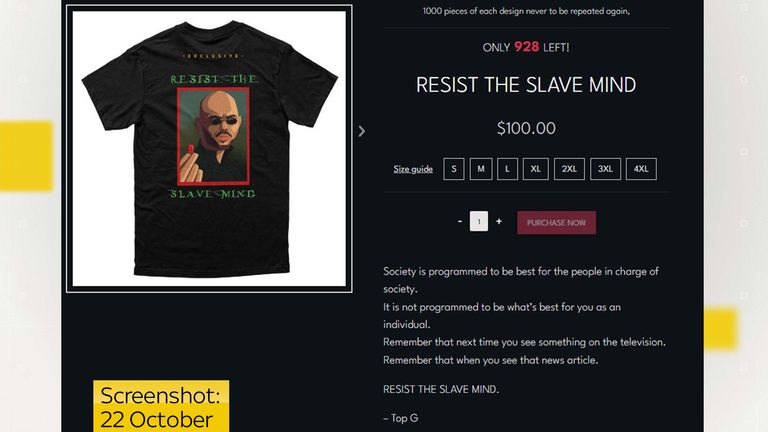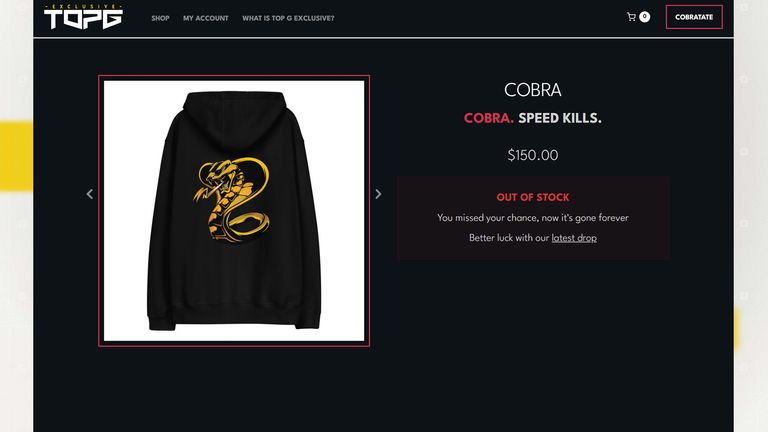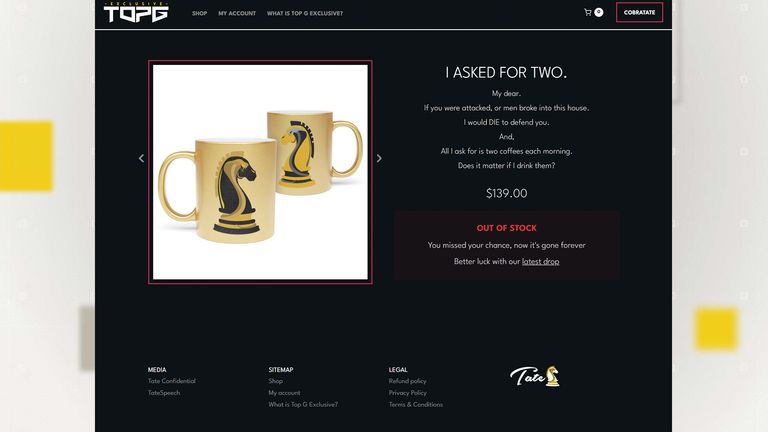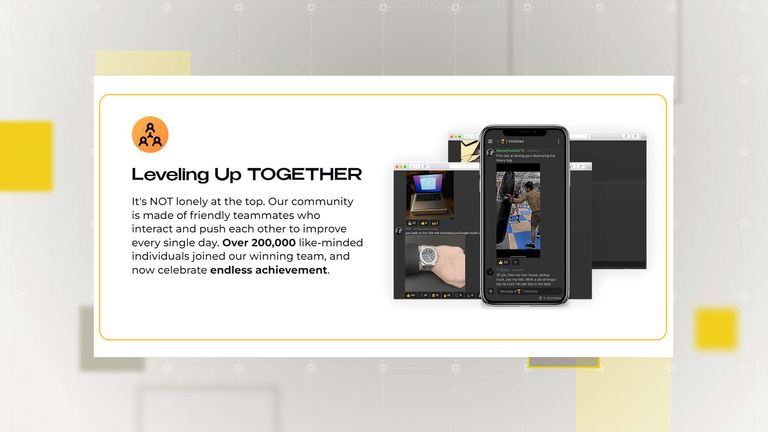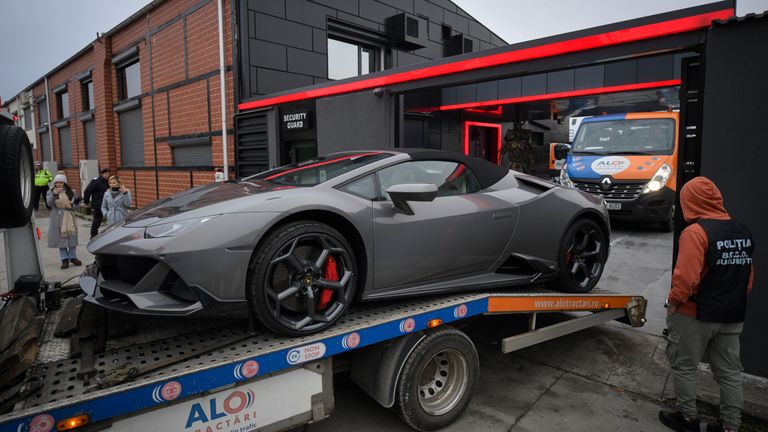
Influencer Andrew Tate gained many of his millions of followers by telling them he’s rich – and he’ll make them rich too.
The self-proclaimed misogynist has gone from posing on yachts and filming himself jetting off to Dubai, to being arrested in December over allegations of being part of an organised crime group, human trafficking and rape.
Symbols of Tate’s apparent wealth, including luxury cars and properties, have been seized by the Romanian police who are investigating Tate, 36, and his brother and business partner, Tristan, 34.
So, with Tate’s assets under the microscope, what is known about how much money his business actually makes?
Speculation about his wealth varies wildly and many of the claims Tate makes about his earnings are unverified, including six-figure sums connected to his “camgirl” business.
It is not known whether this business is connected to the charges facing the brothers and two Romanian women, all of whom deny the claims made against them.
Using publicly available information, Sky News has looked at how much his company might be making through video streaming, as well as selling subscriptions and merchandise.
Video streaming
Banned from Twitter in 2017 (but since reinstated in November 2022), Tate was also removed from YouTube, Instagram, Facebook and TikTok in August 2022 for breaching their terms and conditions. But he had already built up millions of followers on each platform.
His army of fans followed him to anti-“cancel culture” streaming platform Rumble, where Tate’s associates continue to post clips while he is in prison. Rumble’s emphasis on “free speech” has made it popular among right-wing commenters.
Tate claims he signed a $9m (£7.3m) deal with Rumble in 2022, according to CNN. Rumble did not reply to Sky News’ request for comment, but issued a statement to CNN calling for the charges against Tate to be “investigated promptly and thoroughly”.
Sky News has collated Tate’s video streams from his two Rumble channels, TateSpeech and TateConfidential. The former saw higher video views more consistently after he was blocked by other social media sites.
Although TateConfidential is less successful, the two channels collectively mean Tate has amassed huge viewing figures.
Rumble advertises itself as offering some of the most generous amounts paid out per video view, saying that “1,000 views on Rumble.com may earn you as much as 10,000 views on YouTube”.
Sara McCorquodale, chief executive and founder of influencer intelligence CORQ, explains that how much social platforms usually pay out tends to be “a bit of a grey area”.
“[On Rumble] it could be anything from $0.30 to $20 or $50 per 1,000 views,” she said.
“Andrew Tate could be making anything from $600 (£490) to $20,000 (£16,250) for his most prolific videos.”
By this estimate, Tate’s most popular video “EMERGENCY MEETING 1 – THE MATRIX ATTACKS”, which was broadcast five months ago in the days after he was banned from other social platforms could have earned him up to $133,500 (£108,400) after hitting 2.67m views.
As well as earning money through adverts, Rumble gives creators a bonus if their video is hosted on the site’s front page.
Mrs McCorquodale explained that Tate’s potential earnings on Rumble show just how large his following is, despite the influencer not having access to most mainstream social media sites.
She said: “It shows the numbers of views we are seeing on Andrew’s channels are all coming from his audience.
“This is quite worrying because it shows the scale at which he has attracted people to his narrative.
“Andrew Tate is very much aiming his content at young men… He tries to be aspirational, but then he also tries to connect with young men by seemingly understanding the challenges they face in society today.”
Manosphere merchandise
With Tate banned from most social media, his fans flock to his website – including to buy merchandise to support him.
Activity on his merchandise page has been saved by the Internet Archive project, a digital library of websites. Its records can not be edited or altered.
Using it, we can see how many items were advertised as for sale, at what price and on what date they were listed as having sold out by.
A screenshot of Tate’s online merchandise store on 22 October shows that a T-shirt named “Resist the Slave Mind” was on sale.
It shows Andrew Tate dressed like a character from the 1999 film The Matrix while holding a red pill. The red pill, a motif from the movie, is popular symbol in what is known as the “manosphere”, a loosely connected groups of online misogynists.
The now sold-out shirts were on sale for $100 (£81) each with 1,000 in stock.
This means the T-shirts would have brought in $100,000 (£81,000) of revenue. This is the overall figure earned and would not include any outgoings or division of profit.
These calculations are being made based on figures provided by Tate’s website.
These figures may be unreliable, with Sky News discovering that at least one claim on the site is wrong.
Tate’s website claims the Resist the Slave Mind T-shirt sold out in the specific timeframe of 25hrs 19m and 43 seconds.
However, archived pages show the T-shirt on sale on 22 October, was still on sale on 5 November and was listed as sold out by 7pm the following day.
This means the T-shirt was on sale for more than two weeks, rather than just over a day.
Other sales on his site recorded by the archive include another T-shirt named “Vision”. It was put on sale for $100 (£81) per shirt with 651 listed as available, earning a potential $65,100 (£52,700).
A hoodie, “Cobra”, was on sale for $150 (£120) but the internet archive did not record how many units were available.
A pair of mugs were on sale for $139 (£113) with 888 on offer, potentially generating $123,400 (£100,000).
This means, since the end of October, $265,100 (£215,000) may have been generated through merchandise alone – not including the $150 hoodies, of which we don’t have a verifiable stock figure for.
Tate also sells supplements on his website, priced at $54.99 (£44.50).
We don’t have stock figures to access through the archive, but data provided to Sky News from website analytics company SimilarWeb can give us an insight.
They estimate that the number of hits on the checkout page for supplements in November was around 6,500 and in December around 3,100. While a person visiting the checkout page does not guarantee a sale is made, it does give a sense of how many users are getting to that stage of the purchasing process.
Money-making memberships
Tate sells access to schemes that are advertised as teaching people how to make money online through sessions on skills such as copywriting and crypto-trading.
This is “a classic influencer strategy” that Andrew Tate has put his own spin on, says Mrs McCorquodale.
“The clever thing Andrew Tate has done is recognise that he is a divisive character. Many people may not want to be seen as a fan of him publicly but are buying his subscriptions and engaging privately.
“His subscriptions allow people to engage without risk of judgement. This is crucial.”
There are two levels of access. The first is “The Real World”, a new incarnation of the Hustler’s University, which was shut down last year.
Subscribers pay $49.99 (£40) a month for access to group chat rooms, tutorials and “millionaire mentors”. For those signing up early, an entry fee of $27 (£22) was payable, which later increased to $147 (£120).
The website claims over 200,000 people have transferred over from Hustler’s University or joined the scheme when it launched in November. This would bring in at least $9,998,000 (£8,089,140) a month in subscriptions if that figure is accurate.
However, Sky News has seen a Telegram group for The Real World where members of Hustler’s University were automatically added. It only has 126,255 subscribers.
The number of views each announcement in the group gets has dropped from around 230,000 at the start to around 45,000 in January.
Web traffic to the log in page for The Real World is also much lower than the membership figure would suggest.
Less than 100,000 hits were registered by VStat, another web traffic monitor, in January. The service is unable to give a more precise audience figure when views are this low.
Tate’s other subscription service is The War Room, where membership is significantly more expensive, at $5,454 (£4,400), which must be paid via cryptocurrency.
It is not possible to find a reliable independent figure which could indicate how many people are subscribed to The War Room.
Sky News contacted Tate’s lawyer for comment regarding the figures set out in this article but did not receive a response.
Click to subscribe to the Sky News Daily wherever you get your podcasts
What can we learn from this snapshot of Tate’s earnings?
For Mrs McCorquodale, Sky News’ findings goes some of the way towards answering if these earnings tally with Tate’s displays of wealth.
“What’s clear is he has multiple revenue streams which all link back to him monetising his digital audience and mean he is less reliant on mainstream social media platforms,” she said.
“These let him continually push a message and amass more new customers but ultimately he is trying to get them off those platforms and onto his own [such as] his War Room subscription.”
The future of Tate’s earnings may well be hit by the police investigation, with Mrs McCorquodale highlighting the falling viewing figures on Rumble after his arrest.
She said: “Many people may like what he’s saying and think the controversy around him is overblown. But the minute there is a chance he might actually be a criminal, they’re out.
“Perhaps this has made consumers review more carefully who he is and his real impact beyond making people annoyed on Twitter.”
The Data and Forensics team is a multi-skilled unit dedicated to providing transparent journalism from Sky News. We gather, analyse and visualise data to tell data-driven stories. We combine traditional reporting skills with advanced analysis of satellite images, social media and other open source information. Through multimedia storytelling we aim to better explain the world while also showing how our journalism is done.
Why data journalism matters to Sky News



